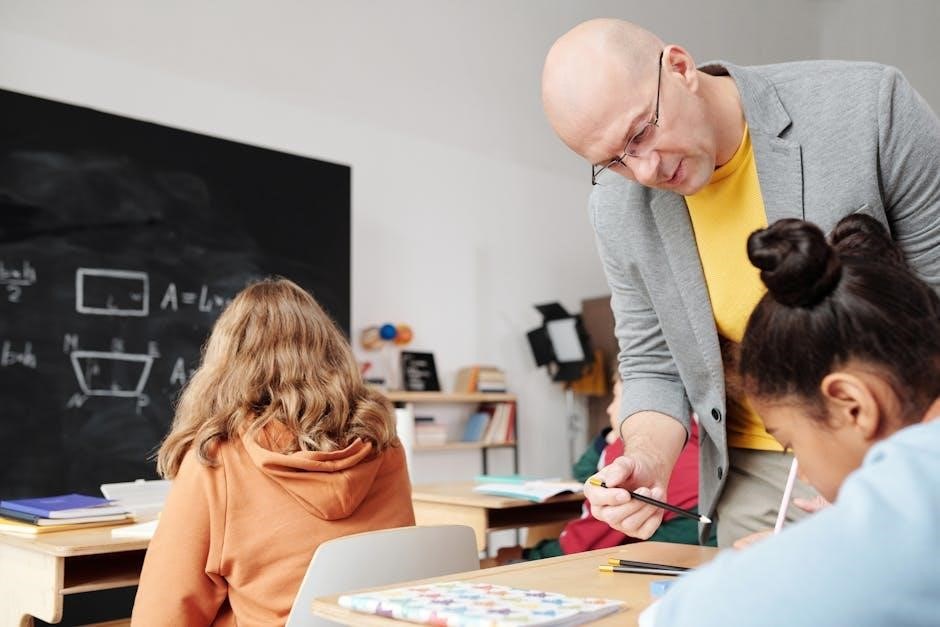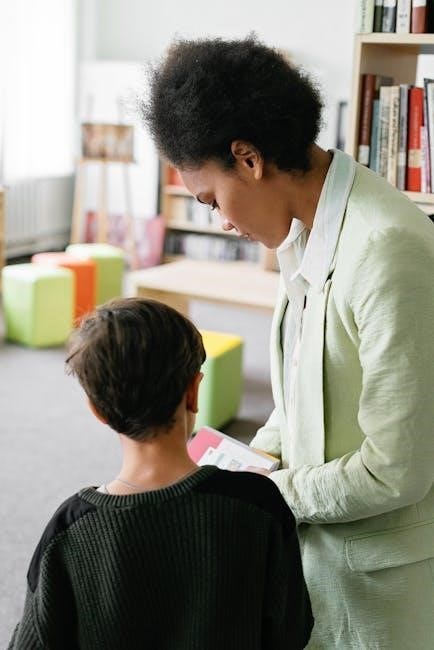Understanding the Foundations of Literacy Instruction
Understanding the foundations of literacy instruction involves recognizing the importance of phonemic awareness, systematic phonics, and comprehension strategies. Teachers must use evidence-based practices, integrate technology, and create inclusive environments to meet diverse learning needs. This approach ensures all students develop essential reading and writing skills, promoting lifelong learning and academic success.
Defining Literacy in the Modern Era
Modern literacy extends beyond traditional reading and writing skills, encompassing digital proficiency, critical thinking, and the ability to interpret diverse media. It involves understanding how information is created, organized, and used effectively in a technology-driven world. Literacy today requires students to navigate complex sources, evaluate information critically, and communicate ideas across multiple platforms. This broader definition reflects the evolving demands of society, where adaptability and lifelong learning are essential. By integrating these skills, educators ensure students are prepared to engage meaningfully in an increasingly interconnected and information-rich global community.
The Importance of Literacy in Student Development
Literacy is a cornerstone of student development, fostering academic success, critical thinking, and lifelong learning. It empowers students to access information, express ideas, and engage with the world around them. Proficient literacy skills enhance problem-solving abilities and open doors to diverse opportunities. Literacy also builds confidence, enabling students to participate fully in educational and societal activities. Moreover, it lays the foundation for future career prospects and personal growth. By prioritizing literacy, educators equip students with tools essential for navigating an increasingly complex and information-driven world. This underscores the critical role of literacy in shaping both individual and societal progress.
Historical Development of Literacy Education
The history of literacy education reflects societal changes and evolving educational philosophies. Early civilizations, such as Egypt and Mesopotamia, reserved literacy for religious and political elites. The Middle Ages saw monasteries preserving literacy, primarily for religious purposes. The Renaissance brought the printing press, expanding access to books and fostering broader literacy. Industrialization led to mass education systems, making literacy more widespread. The 20th century emphasized pedagogical research, introducing phonics and whole-language approaches. Today, literacy education prioritizes inclusivity, addressing diverse learning needs and leveraging technology. This historical journey underscores the transformation of literacy from an elite privilege to a foundational skill for all students, shaping modern educational practices.

Recognizing Diverse Learning Needs
Recognizing diverse learning needs requires understanding individual differences in abilities, learning styles, and cultural backgrounds. Teachers must adapt instruction to meet varied student requirements, ensuring equitable literacy opportunities.
Addressing Learning Disabilities in Literacy
Addressing learning disabilities in literacy requires tailored strategies to support students with diverse needs. Early identification and assessment are critical to providing appropriate interventions. Multisensory approaches, such as Orton-Gillingham, and assistive technologies can help bridge gaps. Teachers should use scaffolded instruction, breaking skills into manageable steps, and incorporate visual aids to enhance comprehension. Collaboration with special education professionals and families ensures comprehensive support. By fostering an inclusive environment and leveraging evidence-based practices, educators can empower students with learning disabilities to achieve literacy success and build confidence in their abilities. Personalized learning plans and regular progress monitoring are essential for continuous improvement.
Supporting English Language Learners
Supporting English language learners requires tailored strategies to meet their unique needs. Teachers should use scaffolded instruction, visual aids, and interactive activities to build language and literacy skills. Incorporating students’ cultural backgrounds into lessons fosters engagement and relevance. Explicit teaching of vocabulary, grammar, and comprehension strategies is essential. Technology tools, such as language learning apps, can provide additional practice opportunities. Collaborative learning with peers and access to bilingual resources can enhance their learning experience. Regular progress monitoring and differentiated instruction ensure individualized support. By creating a welcoming and inclusive environment, educators can help English language learners thrive academically and build confidence in their literacy abilities.
Cultural and Socio-Economic Considerations
Cultural and socio-economic considerations play a vital role in shaping literacy instruction. Teachers must recognize and respect students’ diverse backgrounds, incorporating culturally relevant materials to enhance engagement. Socio-economic challenges, such as access to resources, can impact learning, requiring educators to provide equitable opportunities. Understanding these factors helps tailor instruction to meet individual needs. By fostering an inclusive environment that values all cultures and experiences, educators can promote academic success and social-emotional growth. Additionally, partnerships with families and communities can bridge gaps and support literacy development. Addressing these considerations ensures that all students, regardless of background, have the opportunity to thrive in their educational journey.

Evidence-Based Practices in Literacy Instruction
Evidence-based literacy practices emphasize phonemic awareness, systematic phonics, and vocabulary development, supported by research and data-driven instruction to ensure effective learning outcomes for all students.
Phonemic Awareness and Its Role
Phonemic awareness is a foundational skill in literacy instruction, enabling students to identify and manipulate individual sounds in spoken words. This skill is crucial for decoding and reading proficiency. Research shows that explicit teaching of phonemic awareness significantly improves reading abilities, especially for struggling learners. Activities such as sound isolation, blending, and segmenting are effective strategies. Integrating games and interactive tools can make learning engaging. Early intervention and consistent practice ensure students build a strong basis for future reading success. Thus, phonemic awareness is a cornerstone of effective literacy instruction, benefiting all learners and setting them up for long-term academic achievement.
Systematic Phonics Instruction
Systematic phonics instruction is a structured approach to teaching reading by explicitly connecting sounds to letters. It emphasizes the logical progression of phonics skills, from basic to complex, ensuring students master each concept before advancing. This method is evidence-based and widely regarded as effective for all learners. By teaching decoding skills systematically, students build fluency and comprehension. Techniques include multisensory activities and the use of decodable texts. Regular practice and reinforcement are essential to solidify learning. Systematic phonics instruction provides a strong foundation for reading, enabling students to decode unfamiliar words with confidence and accuracy, thereby supporting overall literacy development and academic success.
Vocabulary Development Strategies
Vocabulary development is crucial for enhancing reading comprehension and overall literacy. Effective strategies include explicit instruction of high-utility words, repeated exposure to vocabulary in various contexts, and interactive activities like word mapping. Teachers should incorporate authentic texts that naturally introduce new words, allowing students to see vocabulary in action. Encouraging independent reading also expands students’ exposure to diverse vocabulary. Technology tools, such as educational apps and online resources, can reinforce learning through engaging exercises. Additionally, discussions and collaborative tasks help students deepen their understanding of word meanings. By integrating these strategies, educators ensure students develop a robust vocabulary, equipping them for academic success and lifelong learning.
Comprehension Strategies for All Learners
Effective comprehension strategies empower students to engage deeply with texts, fostering understanding and critical thinking. Techniques like summarization, self-questioning, and visualization help learners process information actively. Teaching students to identify main ideas and supporting details enhances their ability to analyze texts. Additionally, incorporating graphic organizers and think-aloud protocols allows students to visualize and articulate their thoughts. Differentiated instruction ensures that all learners, including those with diverse needs, can access and benefit from these strategies. By modeling and explicitly teaching comprehension skills, educators equip students with tools to succeed in various academic contexts and develop a lifelong love for reading.

Implementing Differentiated Instruction
Differentiated instruction tailors learning experiences to meet diverse student needs, using tiered approaches, learning centers, and small groups to enhance engagement and comprehension for all learners.
Tiered Instructional Approaches
Tiered instructional approaches involve organizing learning into multiple levels to cater to varying student abilities. The three-tier model includes high, medium, and low support, ensuring each student receives tailored instruction. High-tier students engage with complex texts and independent tasks, while medium-tier students benefit from guided practice and scaffolding. Low-tier students receive intensive support, such as one-on-one instruction and explicit skill-building exercises. This strategy ensures that all learners, regardless of their proficiency level, have access to meaningful and challenging content, fostering academic growth and confidence.
Learning Centers and Small Groups
Learning centers and small groups are effective strategies for differentiated instruction, allowing teachers to cater to diverse learning needs. These structured activities enable active participation, fostering collaboration and personalized learning. Learning centers often include hands-on tasks like reading stations, writing workshops, and technology-based exercises. Small group instruction allows teachers to target specific skills, such as phonics or comprehension, providing direct support and feedback. This approach ensures that all students engage meaningfully with content, regardless of their proficiency level, and promotes a dynamic, inclusive classroom environment. By integrating these methods, educators can address individual learning gaps and enhance overall academic growth effectively.
Technology Integration for Personalized Learning
Technology integration enhances literacy instruction by providing personalized learning opportunities tailored to individual student needs. Educational software and apps offer adaptive learning experiences, allowing students to progress at their own pace. Digital tools, such as interactive reading platforms and writing assistants, engage learners and provide immediate feedback. Integrating technology also facilitates data-driven instruction, enabling teachers to track progress and adjust strategies. By leveraging these tools, educators can create dynamic, inclusive learning environments that cater to diverse abilities and learning styles. This approach not only improves academic outcomes but also prepares students for a technology-driven future, fostering digital literacy and critical thinking skills.

Assessment and Feedback in Literacy
Effective assessment and feedback are crucial in literacy instruction, guiding teachers to tailor instruction and enhance student skills. Regular evaluations and constructive responses foster growth and confidence.
Initial Assessments for Baseline Understanding
Initial assessments are crucial for identifying students’ literacy skills and knowledge gaps. Teachers use standardized tests, reading inventories, and writing samples to gather baseline data. This step ensures instruction is tailored to individual needs, fostering growth. By evaluating prior knowledge and skills, educators can set realistic goals and track progress effectively. These assessments also guide the development of personalized learning plans, ensuring all students receive targeted support. Regular evaluations help refine instruction, making it more impactful and student-centered. Initial assessments lay the foundation for successful literacy instruction, enabling educators to address diverse needs and promote academic success for all learners.
Formative Assessments to Guide Instruction
Formative assessments are ongoing evaluations used to monitor student progress during literacy instruction. These assessments include quizzes, class discussions, and writing assignments, providing immediate feedback to both teachers and students. By identifying strengths and weaknesses, educators can adjust their teaching strategies to better meet student needs. Formative assessments help students understand their own learning, fostering self-awareness and motivation. They also allow teachers to differentiate instruction, ensuring all learners receive appropriate support. Regularly administering formative assessments ensures that literacy instruction remains responsive and effective, ultimately enhancing student outcomes and promoting a growth-oriented learning environment.
Using Data to Inform Instructional Decisions
Using data to inform instructional decisions is critical in creating effective literacy instruction. Teachers collect and analyze data from formative assessments, progress monitoring tools, and standardized tests to identify student strengths and areas needing improvement. This data helps refine teaching strategies, ensuring targeted support for all learners. By tracking student growth over time, educators can adjust instruction to meet individual needs and measure the impact of interventions. Data-driven decision-making fosters a culture of accountability and continuous improvement, ensuring that literacy instruction is personalized, equitable, and aligned with learning goals. Regular review of data enables teachers to celebrate successes and address challenges promptly.

Creating an Inclusive Classroom Environment
Creating an inclusive classroom involves designing the physical space to promote interaction, integrating social-emotional learning, and using culturally responsive practices. This fosters a welcoming environment for all students.
Designing the Physical Learning Space
Designing the physical learning space involves creating a flexible, accessible, and engaging environment that supports literacy instruction for all students. Arrange desks in small groups or pairs to foster collaboration and accessibility. Incorporate comfortable seating options, such as bean bags or standing desks, to cater to diverse learning preferences. Ensure proper lighting and minimize distractions to enhance focus. Display charts, word walls, and student work to create a visually stimulating atmosphere. Organize materials, such as leveled readers and writing tools, in easily accessible locations. Use technology, like interactive whiteboards, to integrate digital learning seamlessly. A well-designed space promotes inclusivity, engagement, and academic success for all learners.
Integrating Social-Emotional Learning
Integrating social-emotional learning (SEL) into literacy instruction fosters a supportive classroom environment that promotes self-awareness, empathy, and collaboration. Encourage students to share personal connections to texts, fostering deeper understanding and emotional engagement. Use group discussions and role-playing activities to develop communication and teamwork skills. Teach mindfulness practices to help students manage stress and stay focused during reading and writing tasks. Incorporate reflective journals or discussion circles to build self-awareness and self-regulation. By integrating SEL, educators create a holistic learning experience that addresses both academic and emotional growth, ensuring students feel valued and empowered to succeed in literacy and beyond.
Engaging Families in Literacy Development
Engaging families in literacy development is crucial for fostering a collaborative learning environment. Schools can organize family literacy workshops, where parents learn strategies to support their children’s reading and writing skills at home. Providing families with access to digital resources and reading materials encourages shared literacy experiences. Encouraging parents to participate in classroom activities, such as reading aloud or assisting with small groups, strengthens the home-school connection. Regular communication through newsletters or parent-teacher conferences helps keep families informed and involved. By empowering families to play an active role, educators create a network of support that enhances students’ literacy growth and overall academic success.

Technology Integration for Enhanced Literacy
Technology integration enhances literacy through interactive tools, educational apps, and multimedia resources; Personalized learning paths, real-time feedback, and accessibility features like text-to-speech support diverse learners, fostering engagement and progress.
Educational Software and Apps
Educational software and apps play a crucial role in creating literacy instruction for all students by providing personalized learning experiences. These tools offer interactive and engaging activities tailored to individual needs, such as phonics games, vocabulary builders, and comprehension exercises. Many apps incorporate multimedia elements like audio and video to enhance understanding. Additionally, they often include features like text-to-speech and speech-to-text, making them accessible to students with diverse learning abilities. Teachers can track progress through built-in assessments, allowing for data-driven instruction. By leveraging these digital resources, educators can create dynamic and inclusive literacy programs that cater to every student’s unique learning style and pace.
Digital Tools for Interactive Learning
Digital tools for interactive learning enhance engagement by providing hands-on activities and collaborative opportunities. These tools, such as interactive whiteboards and multimedia presentations, allow students to explore literacy concepts dynamically. Real-time collaboration features enable peer-to-peer interaction, fostering a sense of community. Gamification elements, like badges and quizzes, motivate students to practice reading and writing skills. Additionally, virtual classrooms and breakout rooms facilitate personalized instruction; These tools also support differentiated instruction, ensuring all learners, including those with special needs, can participate meaningfully. By integrating these digital resources, educators create immersive and inclusive learning environments that cater to diverse student needs and preferences.
Curating Online Resources for Literacy
Curating online resources for literacy involves selecting and organizing high-quality materials to support diverse learning needs. Educators can use digital libraries, educational apps, and interactive websites to provide engaging and accessible content. These resources often include multimedia elements, such as videos, podcasts, and games, to cater to different learning styles. Teachers should regularly update their collections to ensure relevance and alignment with curriculum goals. Additionally, tools like bookmarks, folders, and shared links help students and parents access materials easily. This approach promotes personalized learning, allowing students to explore topics at their own pace. Effective curation also fosters collaboration, as resources can be shared across classrooms, enhancing the overall literacy experience for all students.

Culturally Responsive Teaching Practices
Culturally responsive teaching involves using diverse materials and perspectives to create an inclusive environment. This approach helps students connect with the curriculum and feel valued in their learning journey.
Culturally Relevant Teaching Materials
Culturally relevant teaching materials are essential for creating inclusive literacy instruction. These materials reflect students’ diverse backgrounds, experiences, and perspectives, fostering engagement and connection to the curriculum. Educators should select texts and resources that represent various cultures, languages, and identities, ensuring all students see themselves in the content. This approach promotes equity and validates students’ cultural identities, enhancing their motivation to learn. Additionally, culturally responsive materials help bridge gaps between home and school, creating a supportive environment where students feel valued. By integrating diverse voices and stories, teachers can address socio-economic and cultural considerations, ensuring literacy instruction is accessible and meaningful for all learners.
Representing Diverse Perspectives
Representing diverse perspectives in literacy instruction ensures that all students see themselves reflected in the curriculum. This involves selecting materials that include a wide range of voices, experiences, and viewpoints, fostering empathy and understanding. Educators should prioritize texts that highlight cultural, racial, gender, and socio-economic diversity, ensuring every student feels valued. By integrating diverse perspectives, teachers create an inclusive environment that encourages engagement and deeper comprehension. This approach also prepares students to navigate a global, interconnected world by exposing them to varied viewpoints and fostering critical thinking. Ultimately, diverse representation enriches learning and helps students develop a broader understanding of the world.

Professional Development for Educators
Professional development for educators emphasizes ongoing education, information literacy, and technology integration. It fosters collaboration, enhancing teaching methodologies to create equitable literacy instruction for all students.
Collaborative Professional Learning
Collaborative professional learning involves educators working together to enhance literacy instruction. Through shared resources, technology integration, and evidence-based practices, teachers can develop targeted strategies. This approach fosters a supportive environment where educators share insights, addressing diverse student needs effectively. By leveraging information literacy and digital tools, collaborative learning promotes continuous improvement in teaching methodologies. This collective effort ensures that all students receive equitable, high-quality literacy instruction, preparing them for academic success and lifelong learning.
Mentorship and Coaching Programs
Mentorship and coaching programs play a vital role in enhancing educators’ abilities to create effective literacy instruction. Experienced mentors provide guidance, share strategies, and offer feedback, helping teachers refine their skills. Coaching programs, often involving classroom observations and tailored support, enable educators to implement evidence-based practices. These programs foster professional growth, ensuring teachers are equipped to address diverse learning needs. By leveraging mentorship and coaching, educators can develop personalized instruction, improve student outcomes, and create inclusive learning environments. Such collaborative support systems are essential for sustaining high-quality literacy education and empowering teachers to meet the unique needs of all students effectively.
Ongoing Education and Certification
Ongoing education and certification are crucial for educators to stay updated on best practices in literacy instruction. Continuous professional development ensures teachers are well-versed in evidence-based methods, enabling them to adapt to evolving educational needs. Certification programs provide specialized knowledge, such as structured literacy or dyslexia intervention, enhancing instructional effectiveness. These programs often include training on technology integration and cultural responsiveness, ensuring educators can meet diverse student needs. By prioritizing ongoing education, teachers maintain high standards of instructional quality, ultimately improving student outcomes. Such commitments not only benefit individual educators but also elevate the overall quality of literacy education across the education system.
Community Partnerships for Literacy
Community partnerships enhance literacy by engaging local organizations, promoting shared resources, and fostering collaborative efforts to support student reading and writing development.
Collaborating with Local Organizations
Collaborating with local organizations strengthens literacy programs by providing access to resources, expertise, and funding. Partnerships with libraries, NGOs, and businesses can offer workshops, materials, and mentorship, enriching students’ learning experiences. These collaborations also foster community engagement, ensuring literacy initiatives align with local needs and priorities. By leveraging external support, schools can enhance their capacity to deliver comprehensive literacy instruction, ultimately benefiting all students and promoting academic success.
Engaging Public Libraries
Engaging public libraries is a vital strategy for enhancing literacy instruction. Libraries provide free access to books, digital tools, and educational programs, making them invaluable resources for students. They often collaborate with schools to support reading initiatives and offer workshops that align with curriculum goals. Public libraries also cater to diverse learners by providing materials in multiple languages and formats, ensuring inclusivity. By leveraging these resources, educators can create enriched learning experiences that foster a love for reading and improve literacy outcomes. Libraries serve as community hubs, bridging the gap between schools and homes, and play a significant role in promoting lifelong learning for all students.

Monitoring Progress and Continuous Improvement
Monitoring student growth through regular assessments ensures tailored instruction. Tracking progress helps refine teaching strategies, fostering continuous improvement and better literacy outcomes for all learners.
Tracking Student Growth and Development
Tracking student growth involves regular assessments and data analysis to monitor progress. Using tools like formative assessments and progress monitoring software allows educators to identify strengths and areas needing support. By analyzing data, teachers can adjust instruction to meet individual needs, ensuring continuous improvement. This process helps create personalized learning plans, fostering academic success. Regularly reviewing student development ensures that literacy instruction remains effective and tailored to each learner’s pace. This approach supports the creation of a responsive and adaptive learning environment, promoting equity and excellence in literacy education for all students.
Refining Instruction Based on Outcomes
Refining instruction based on outcomes involves analyzing assessment data to identify areas of strength and improvement. By evaluating student performance, educators can modify teaching strategies to address specific needs. This iterative process ensures that literacy instruction remains targeted and effective. Teachers can incorporate new resources or technologies to enhance engagement and understanding. Regularly reviewing outcomes also allows for professional development opportunities, as educators collaborate to share successful practices. This data-driven approach fosters a culture of continuous improvement, ensuring that all students receive the support they need to achieve literacy goals. Adjusting instruction based on outcomes is essential for creating a responsive and effective learning environment.



